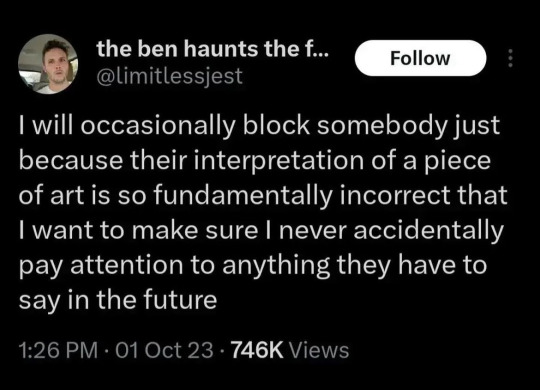Text
does anyone know where I can find good reference images of victorian-era wheelchairs? I want to draw the jovial contrarian but all the wheelchair art refs/tutorials I can find are for modern wheelchairs
27K notes
·
View notes
Text
I love first-person because it’s about what the narrator chooses to tell. What do they focus on? What do they leave out? What can you learn from reading between the lines? Are they lying to you? Are they lying to themself? It’s great for unreliable narrators and for epistolary storytelling! It’s intimate but there’s still a distance because you aren’t really seeing the narrator’s thoughts–you’re just seeing the story that they’ve constructed.
I love second-person because it’s a conversation. Does “you” mean a broad, indefinite “you”? Does “you” really mean “I” but with plausible deniability? Does “you” mean one specific person? Can they hear the narrator? Do they know the narrator? What is the relationship here? Who’s talking? Who’s listening?
I love third-person limited because it’s focused and intimate. What does the world look like from inside this character’s head? What are they seeing? What are they feeling? It doesn’t grant them the privacy that first-person does; the narrative isn’t something they’ve chosen, it’s invisible and inescapable. As a reader you’re not watching so much as astral projecting.
(I love singular point of view because of how much it leans into that limitation. You’re not getting the whole story; you’re not seeing anything unless this character sees it. How do you embrace that? What do you do with the gaps around the edges? How does that define–or warp–the events that they’re experiencing?
I love multiple points of view because of how it broadens your understanding of the story and the world. If two point-of-view characters react in opposite ways to the same thing, what does that tell you about them? About the world? How does it feel to spend time inside a character’s head and then see them from someone’s else’s point of view? How do all of these viewpoints work together?)
I love third-person omniscient because the narrative is a character. It’s great for stories that know they’re stories! It allows for a camaraderie between the narrator and the reader! It allows for wider and more cinematic descriptions because you’re not limited to what a specific person can see! It lets you look at the characters from outside while still giving you the option to delve into their heads because you have full control over what you’re focusing on!
And I love authors who can combine viewpoints in ways you wouldn’t think would work but manage to pull it off! Stories with multiple point-of-view characters where one is first-person and the others are third! Stories that combine first- and second-person! Stories where the omniscient narrator suddenly refers to themself in the first person! Stories where you realize halfway through that you were wrong about who was narrating it!
Isn’t it fantastic that there are so many different ways to tell stories!!!!
10K notes
·
View notes
Text
How to Hold Yourself Accountable as a Professional Writer
Okay maybe you’re not self-employed or professional yet and writing definitely isn’t bringing in the big bucks, but you’d like it to some day, and you’re working right now on making that a reality. This post is for you, because the best time to practice getting into a healthy writing habit and holding yourself accountable to writing for that future where it’s your full time gig is now—before it’s essential to do so.
1. It will never be easy
It’s easy to think that maintaining a schedule or habit for writing would be easy if only it was your full-time gig and all you needed to do. While it might be easier than trying to cram in writing between classes or jobs, it will never be easy. You’re always going to have multiple things going on, there’s always going to be something you could be or need to be doing other than writing. Developing good habits right now, when it is really hard, is going to set you up far better than just waiting for it to get easy before you fully commit to it.
2. Set a schedule that actually works for you
I did a whole post on making a writing schedule you can actually manage and maintain here:
But the TL;DR is that in order to keep to a schedule, you have to make sure it’s attainable. Fit when you write around your other life schedule. For example, if you’re really not a morning person, planning on waking up at 5am every morning to write for a couple hours is probably not something you’ll be able to maintain. But setting aside an hour before bed may be more manageable for you.
3. Form a habit
To train your brain to make your writing schedule a habit you’ll actually stick to, you should make it into a routine. Similar to how you have a bedtime routine that sets you up to feel sleepy at night, a routine that sets you up for writing will make it harder to turn away from your manuscript, and help inspire a productive writing block.
You can create a writing playlist with songs that inspire your project you listen to whenever you begin writing, make a tea or other drink to sip on while you write, grab a snack, share your schedule with a writing buddy and write together, put together a document of inspiring quotes, photos, or other muses you can read, or really anything that gets you into the writing mood. By following this routine every time you set up to write, you’ll train your brain to get into a mindset that will make it easier to stick to your writing block.
4. Reward yourself
Brains love doing things for a reward. Maybe after a productive writing block you can spend some time doing something else you love, like watching an episode of your favourite show, lighting a candle, taking a bath, or having a glass of wine, I don’t know, anything that would give your brain the happy juice in response to your good work.
5. Set deadlines and goals
Writing consistently is basically the majority of the battle. I don’t typically worry about word count, but I do know that it can be helpful for others to set wordcount goals and deadlines to ensure productivity. If that sounds like you, make sure your goals are actionable while also being attainable. “Finish novel” isn’t a great goal, but “write 2000 words per week for three months” could be helpful if you know that 2000 words is attainable for you.
Same as before, you can also set rewards for when you reach your goals. I have a big tattoo upcoming if I complete my goal for the year.
The last tip I have for this point is to try to find an accountabili-buddy to hold you to your goals and deadlines if you think that would be helpful for you. As a professional writer, you may be held accountable by an editor or agent, so practicing through asking a buddy to help you set deadlines and deliverables will help prepare you for writing towards a date.
The TL;DR is find out what works for you and practice doing it consistently! Anything else I missed?
234 notes
·
View notes
Text
More on pre-electricity lighting.
Interesting to see this one pop up again after nearly two years - courtesy of @dduane, too! :->
*****
After experiencing a couple more storm-related power cuts since my original post, as well as a couple of after-dark garden BBQs, I've come to the conclusion that C.J. Cherryh puts far too much emphasis on "how dark things were pre-electric light".
For one thing eyes adjust, dilating in dim light to gather whatever illumination is available. Okay, if there's none, there's none - but if there's some, human eyes can make use of it, some better or just faster than others. They're the ones with "good night vision".
Think, for instance, of how little you can see of your unlit bedroom just after you've turned off the lights, and how much more of it you can see if you wake up a couple of hours later.
There's also that business of feeling your way around, risking breaking your neck etc. People get used to their surroundings and, after a while, can feel their way around a familiar location even in total darkness with a fair amount of confidence.
Problems arise when Things Aren't Where They Should Be (or when New Things Arrive) and is when most trips, stumbles, hacked shins and stubbed toes happen, but usually - Lego bricks and upturned UK plugs aside - non-light domestic navigation is incident-free.
*****
Here are a couple of pics from one of those BBQs: one candle and a firepit early on, then the candle, firepit and an oil lamp much later, all much more obvious than DD's iPad screen.


Though I remain surprised at how well my phonecam was handling this low light, my own unassisted eyes were doing far better. For instance, that area between the table and the firepit wasn't such an impenetrable pool of darkness as it appears in the photo.
I see (hah!) no reason why those same Accustomed Eyes would have any more difficulty with candles or oil lamps as interior lighting, even without the mirrors or reflectors in my previous post.
With those, and with white interior walls, things would be even brighter. There's a reason why so many reconstructed period buildings in Folk Museums etc. are (authentically) whitewashed not just outside but inside as well. It was cheap, had disinfectant qualities, and was a reflective surface. Win, win and win.
*****
All right, there were no switches to turn on a light. But there was no need for what C.J. describes as stumbling about to reach the fire, because there were tinderboxes and, for many centuries before them, flint and steel. Since "firesteels" have been heraldic charges since the 1100s, the actual tool must have been in use for even longer.
Tinderboxes were fire-starter sets with flint, steel and "tinder" all packed into (surprise!) a box. The tinder was easily lit ignition material, often "charcloth", fabric baked in an airtight jar or tin which would now start to glow just from a spark.
They're mentioned in both "The Hobbit" and "The Lord of the Rings". Oddly enough, "Hobbit" mentions matches in a couple of places, but I suspect that's a carry-over from when it was just a children's story, not part of the main Legendarium.
Tinderboxes could be simple, just a basic flint-and-steel kit with some tinder for the sparks to fall on...

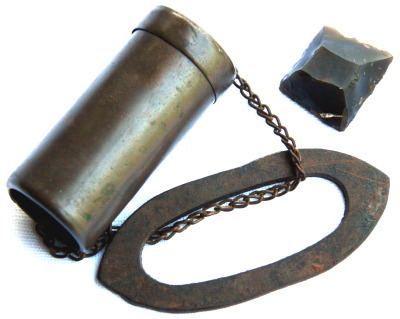

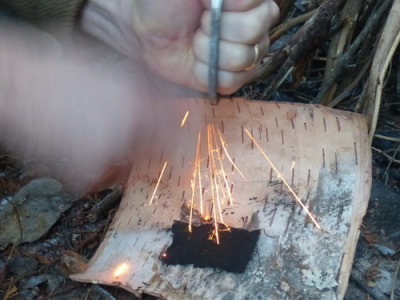
...or elaborate like this one, with a fancy striker, charcloth, kindling material and even wooden "spills" (long splinters) to transfer flame to a candle or the kindling...

This tinderbox even doubles as a candlestick, complete with a snuffer which would have been inside along with everything else.

Here's a close-up of the striker box with its inner and outer lids open:
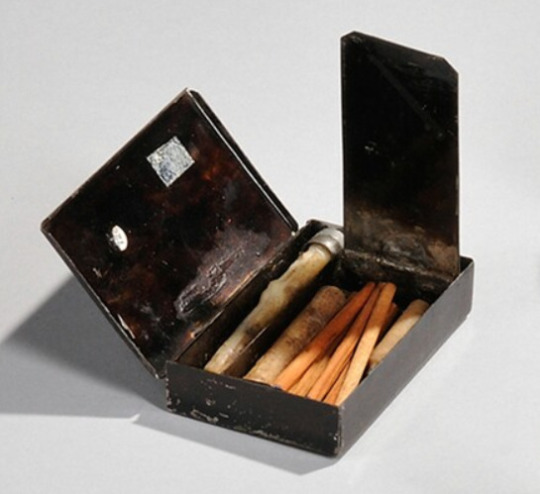
What looks like a short pencil with an eraser is actually the striker. A bit of tinder or charcloth would have been pulled through that small hole in the outer lid, which was then closed.
There was a rough steel surface on the lid, and the striker was scraped along it, like so:

This was done for a TV show or film, so the tinder was probably made more flammable with, possibly, lighter fuel. That would be thoroughly appropriate, since a Zippo or similar lighter works on exactly the same principle.
A real-life version of any tinderbox would usually just produce glowing embers needing blown on to make a flame, which is shown sometimes in movies - especially as a will-it-light-or-won't-it? tension build - but is usually a bit slow and non-visual for screen work.
*****
There were even flintlock tinderboxes which worked with the same mechanism as those on firearms. Here's a pocket version:
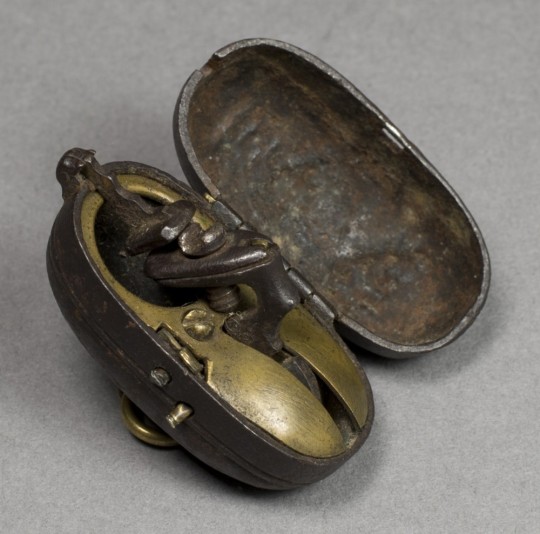
Here are a couple of bedside versions, once again complete with a candlestick:
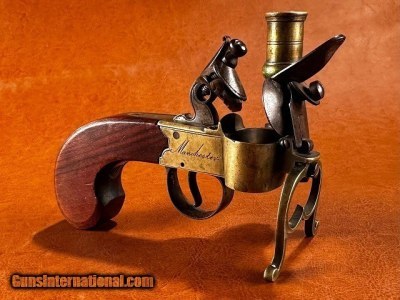
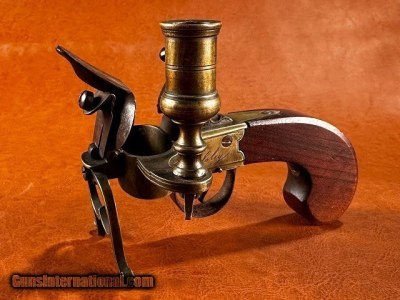
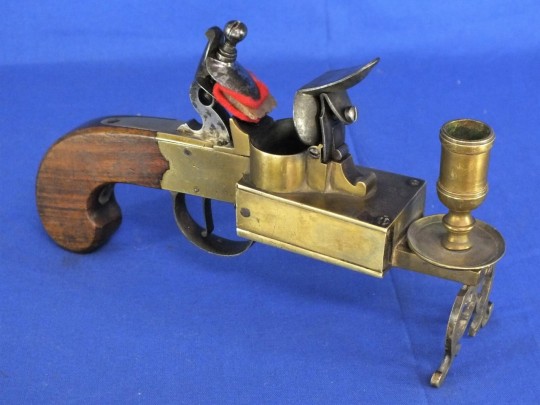
And here are three (for home defence?) with a spotlight candle lantern on one side and a double-trigger pistol on the other.


Pull one trigger to light the candle, pull the other trigger to fire the gun.


What could possibly go wrong? :-P
*****
Those pistol lanterns, magnified by lenses, weren't just to let their owner see what they were shooting at: they would also have dazzled whatever miscreant was sneaking around in the dark, irises dilated to make best use of available glimmer.
Swordsmen both good and bad knew this trick too, and various fight manuals taught how to manage a thumb-shuttered lamp encountered suddenly in a dark alley.
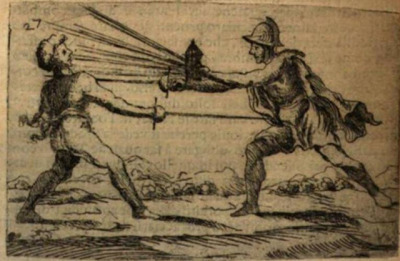
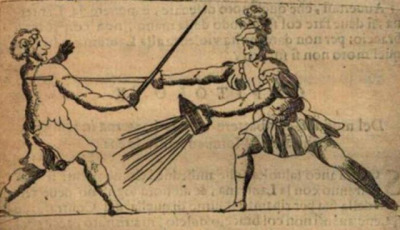
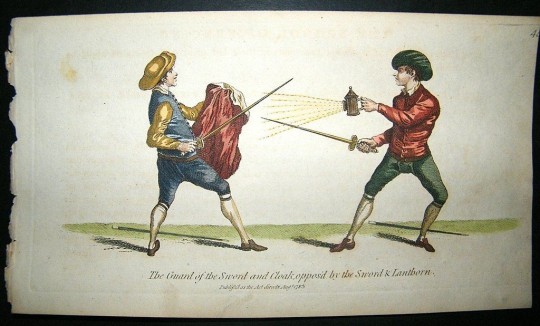
There's a sword-and-lantern combat in the 1973 "Three Musketeers" between Michael York (D'Artagnan) and Christopher Lee (Rochefort), which was a great idea.
Unfortunately it failed in execution because the "Hollywood Darkness" which let viewers see the action, wasn't dark enough to emphasise the hazards / advantages of snapping the lamps open and shut.
This TV screencap (can't get a better one, the DVD won't run in a computer drive) shows what I mean.
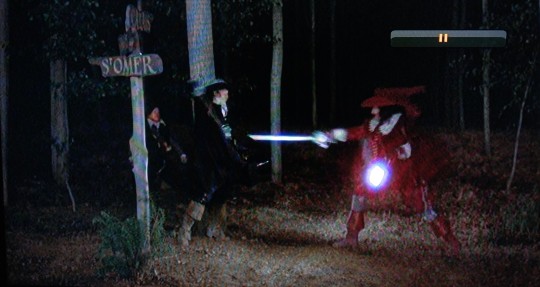
In fact, like the photos of the BBQ, this image - and entire fight - looks even brighter through "real eyes" than with the phonecam. Just as there can be too much dark in a night scene, there can also be too much light.
*****
One last thing I found when assembling pics for the post were Folding Candle-lanterns.
They were used from about the mid-1700s to the later 20th century (Swiss Army ca. 1978) as travel accessories and emergency equipment, and IMO - I've Made A Note - they'd fit right into a fantasy world whose tech level was able to make them.
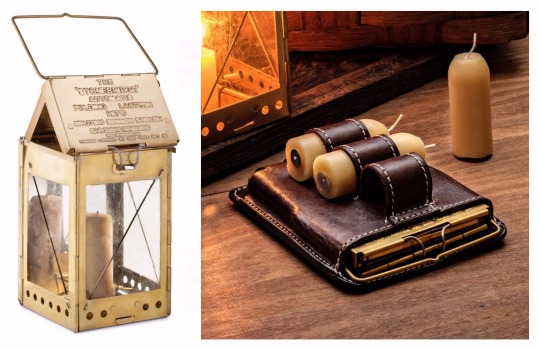
The first and last are reproductions: this one is real, from about 1830.
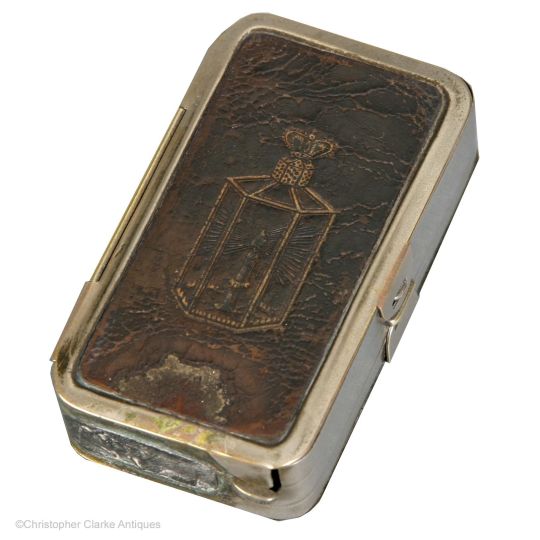
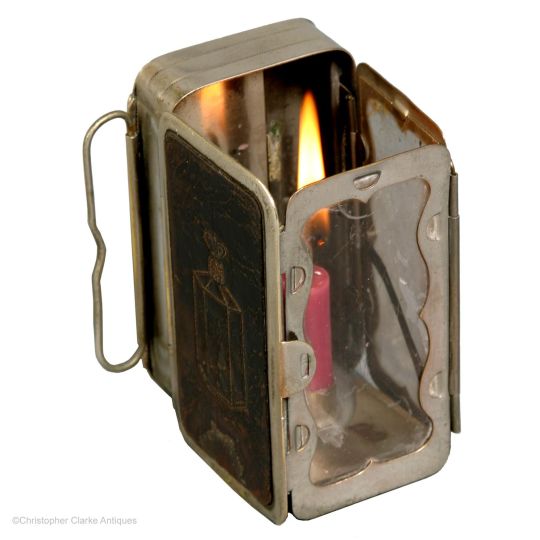
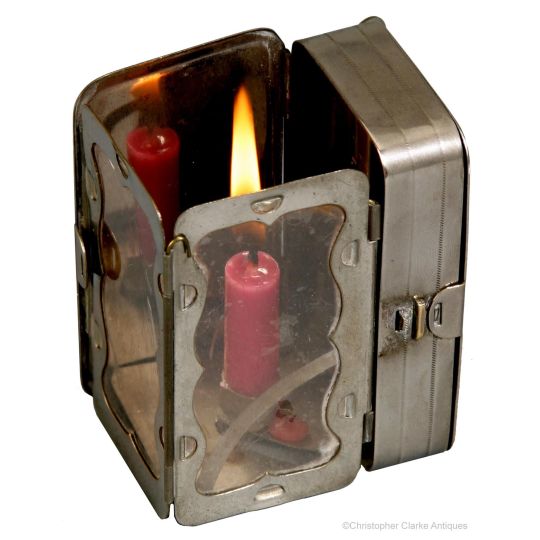
The clear part was mica - a transparent mineral which can be split into thin flexible sheets - while others use horn / parchment, though both of these are translucent rather than transparent. Regardless, all were far less likely to break than glass.
One or two inner surfaces were usually tin, giving the lantern its own built-in reflector, and tech-level-wise, tin as a shiny or decorative finish has been used since Roman times.
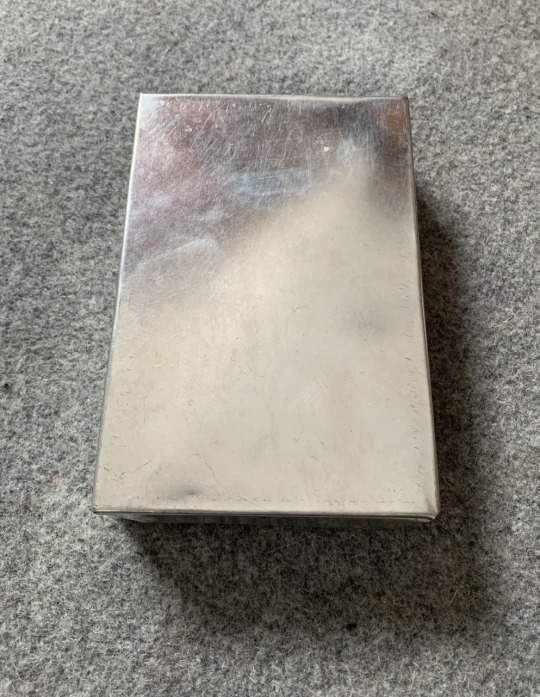

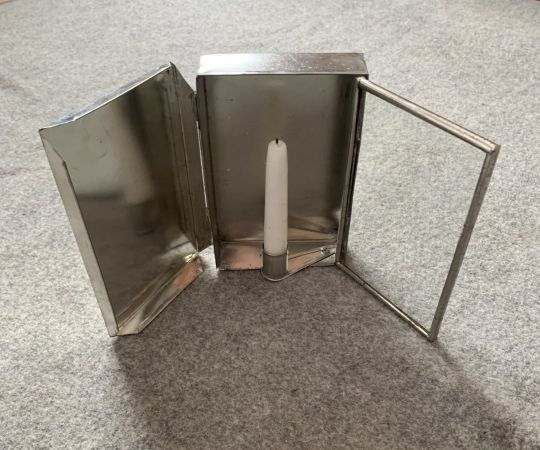
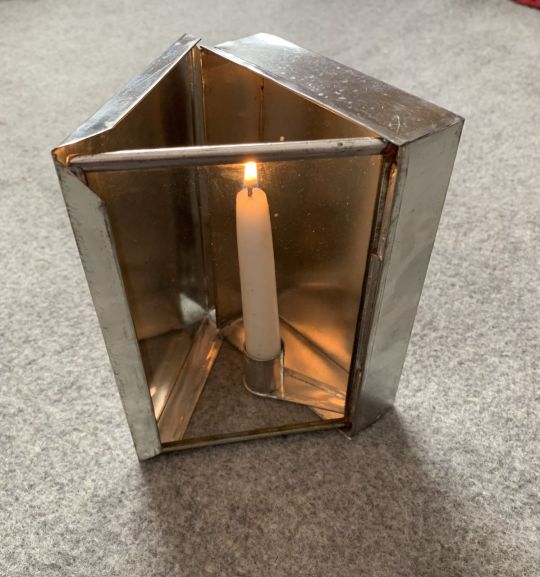
I'm pretty sure that top-of-the-line models could also have been finished with their own matching, maybe even built-in, tinderboxes.
And if real ones didn't, fictional ones certainly could. :->
2K notes
·
View notes
Text
the point of art is not to be great but to make it transparently obvious that there is something wrong with you
99K notes
·
View notes
Text
Critique is literally the life blood of art for the love of god, listen to me!!!!!
3K notes
·
View notes
Text
I am joining funguary this year for the first time. Are you ready for some sapphic mushrooms? 😂
I will do one artwork for each week. If you also want to join funguary, you’ll find the prompts on @feefal instagram profile. 🍄
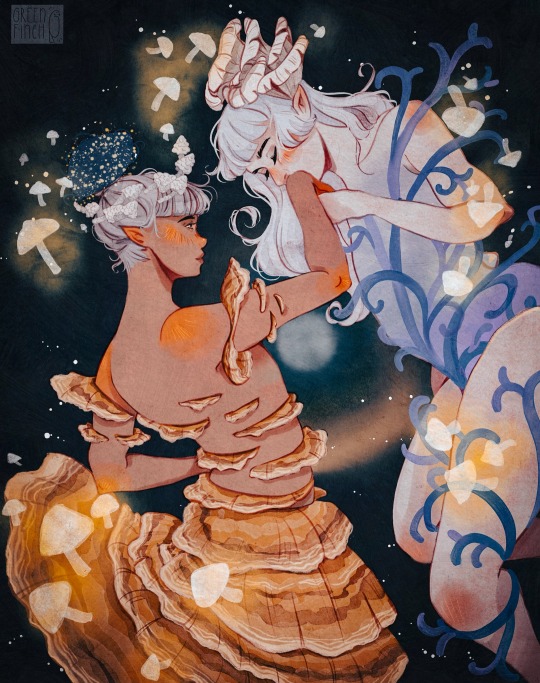
12K notes
·
View notes
Text
People, especially games, get eldritch madness wrong a lot and it’s really such a shame.
An ant doesn’t start babbling when they see a circuit board. They find it strange, to them it is a landscape of strange angles and humming monoliths. They may be scared, but that is not madness.
Madness comes when the ant, for a moment, can see as a human does.
It understands those markings are words, symbols with meaning, like a pheromone but infinitely more complex. It can travel unimaginable distances, to lands unlike anything it has seen before. It knows of mirth, embarrassment, love, concepts unimaginable before this moment, and then…
It’s an ant again.
Echoes of things it cannot comprehend swirl around its mind. It cannot make use of this knowledge, but it still remembers. How is it supposed to return to its life? The more the ant saw the harder it is for it to forget. It needs to see it again, understand again. It will do anything to show others, to show itself, nothing else in this tiny world matters.
This is madness.
173K notes
·
View notes
Text

everyone has their own opinion on the best way to plan a story, but when writing a farce or murder mystery I have to advocate for the classic notecard technique because it opens up the possibility that you will glance down while making lunch and see this
1K notes
·
View notes
Note
I noticed you haven’t been online in 10 hours, is therapy finally working?
this websites hate mail game is ruthless
26K notes
·
View notes
Text
Every single craft has been paying “The Passion Tax” for generations. This term (coined by author and organizational psychologist Adam Grant) — and backed by scientific research — simply states that the more someone is passionate about their work, the more acceptable it is to take advantage of them. In short, loving what we do makes us easy to exploit.
Guest Column: If Writers Lose the Standoff With Studios, It Hurts All Filmmakers
26K notes
·
View notes
Note
I'm writing a scene where character A gets ambushed by an assassin. A gets injured and starts bleeding out. B swoops in to save them in the nick of time, but A starts fading in and out of consciousness. B transports A using a horse-drawn carriage (setting is 1890's London, so no cars) to a safe place for medical attention. Would the carriage be safe enough for transportation or make things worse? Also, any ideas where the wound could plausibly be located on A? (Stab/cut, no guns.)
Okay, so this is a good news/bad news situation.
The good news is that blood loss is really easy to understand. If someone pokes a hole in you, and you start leaking, you'll generally keep leaking at a pretty consistent rate until you manage to stop the leak, or until you start getting additional holes poked in you.
Now, joking aside, moving around, and staying active can accelerate bleed out. Especially if you're engaging in activity that keeps your heart rate up. For example: Running, or fighting. But, normally, you're going to keep losing blood at a fairly consistent rate. (Now, it's worth noting, as you lose blood, your body will actually increase your heart rate to keep oxygen going to your brain. This means that the rate of loss isn't completely consistent. You'll also start hyperventilating.)
The fun part about blood loss is it can actually turn into a math problem. If you know the volume lost per interval, you can calculate roughly how long it will take to die. Just take 2,000, then divide that by the blood lost in milliliters per interval (so, for example, minutes), and then you will know how many minutes your character has before they bleed to death. (Technically you can go over that two liters lost a little bit. (In sloppy napkin math, this means that you'll slightly overestimate how long the character will last.)
Here's the problem.
Hypovolemic shock has four recognized stages. These stages are bracketed by how much blood you've lost. Stage one is up to 15%, Stage two is 15-30%, Stage 3 is 30-40%, and Stage 4 is 40% or more. You might know that the human body has roughly five liters of blood in it, and if you were paying attention you'll notice that two liters is 40% of five liters.
As a quick aside, Stage 1's only symptom is that you'll be a little paler than usual. Otherwise you're basically fine (even if you don't feel particularly great.) To put this in context, you can (almost) lose a liquor bottle's worth of blood without serious side effects.
Once you hit stage 2 and 3, you'll see some mental issues. Anxiety and restlessness at Stage 2, confusion and impaired reasoning at stage 3.
Loss of consciousness (and comas) are symptoms of stage 4 blood loss.
This is the bad news. If you are losing consciousness from loss of blood, you have already lost so much blood that your body (and possibly your brain) are already dying. Humans can lose a frightening amount of blood before it incapacitates them. And, that fun little math problem earlier, the time to death that you're calculating, is also the time to loss of consciousness, because there's a tiny margin between, you bled to the point that you're drifting in and out of consciousness, and, you have bled to death.
There's still some hope here, but it's not great. First aid for hypovolemic shock is to stop the bleeding. It kinda makes sense, because if you don't, they'll bleed to death and after that, it won't really matter. That means, if you're swooping in to the rescue, the first thing you need to do is stop the bleeding, as best you can. When you're already looking at someone in stage 3 or 4, you're not going to stop it in the field, and the best you can do is buy time. But that is a critical step.
This leads to a really important question. How long did it take your character to lose two liters of blood?
Because, if they lost that much blood duringthe fight (which is, actually possible with some arterial hits), there is no medical science that would keep them alive long enough to get them to a surgeon. Not in 1890, and even in 2024 it'd be touch and go with modern emergency trauma packs.
This is a mortal wound.
Now, if you slow it down, and they're bleeding out over the course of the ride, that's entirely feasible. You'll probably want to read up on the exact stages of hypovolemic shock, keep in mind that the stages do transition from one into the next. And, keep in mind that, “slipping in and out of consciousness,” is basically the end. At that point they're about to die. Immediate surgical attention could still save their life, but they need a hospital. This is beyond the scope of what a back alley clinic could reasonably deal with.
I know I didn't address it earlier, but, “where,” could be pretty much wherever. So long as it didn't sever an artery, because at that point they would be dead. Arterial nicks could result in serious bleeding over time. Really, any serious, persistent blood loss that refuses to clot could create a situation like this. Deep tissue penetration, particularly when it damages internal organs, can be pretty nasty, and surprisingly hard to stop a bleed. If someone is hemorrhaging internally, that's going to require surgical attention to keep them alive, and any effort to stop the bleed will really be wasted effort (because they'll continue bleeding into the chest cavity), though, unless your characters have a pretty solid grasp of anatomy, they're unlikely to know that.
The real issue here, from a practical application, is just the, “swooping in at the last minute.” If you're really coming in at the last minute, you've got a minute to make peace with their death, and move on. If you get there sooner, you have more of a scene. You have more options to spool out the drama, and subvert expectations.
Consider, alternately: Your character comes in to disrupt the assassin, and the pair make their escape. While escaping, the character who's been injured discovers they're bleeding. Leading their rescuer to realize that the situation is much worse than they initially thought, and having to change route to a hospital, while the injured character starts to become less coherent.
In this alternative, you can carefully track how quickly the character is bleeding out, so that they're getting into the hospital right around the time it's starting to become touch and go. With a real possibility that they'll die, either before or during surgery. (Also, with added stress that now your character needs to keep them safe in a public space, while that assassin is still on the loose, and they can't move the injured character to someplace more secure.)
So, you've got options, and now you've got a math problem you can play with to figure out how quickly your characters will expire after you poke new holes in them.
-Starke
This blog is supported through Patreon. Patrons get access to new posts three days early, and direct access to us through Discord. If you’re already a Patron, thank you. If you’d like to support us, please consider becoming a Patron.
455 notes
·
View notes
Text
why is it that every time I log into my writer twitter account every single tweet is about some other writer doing something heinous
0 notes
Text
I'm always criticizing eurocentric fantasy worldbuilding, but one thing I think it's underused are city-states and trade republics and leagues. Not that they don't exist, but they're often in the background, the fantasy genre is so focused on monarchies and dynasties and noble drama, while those systems have so much room for intrigue and stuff without getting into "who's the TRUE heir of the super magical monarch" (yes, I know they had aristocratic families that ruled almost as monarchs, but trust me, Medici drama is another beast from regular feudal stuff)
Venice with its stupidly complex election system and their eternal rivals in Genoa, Florence home of the Rennaissance, the Hanseatic League, and lesser known examples like Novgorod, the Polish-Lithuanian Commonwealth, the Taifa of Córdoba, the Consolat de Mar (technically not a republic but kind of an Iberian Hansa) and if we go farther back, the leagues of city states of antiquity... you know what, I'm bored of feudalism. Next time I do a fantasy setting, it will all be city states and republics. Fuck feudalism.
4K notes
·
View notes


